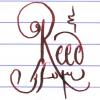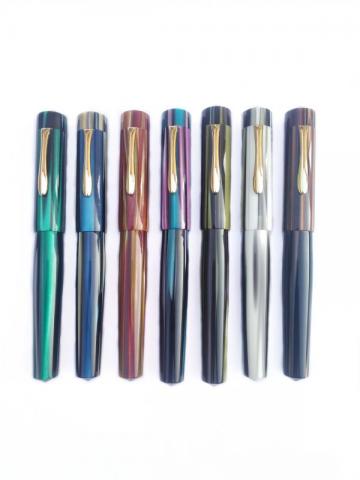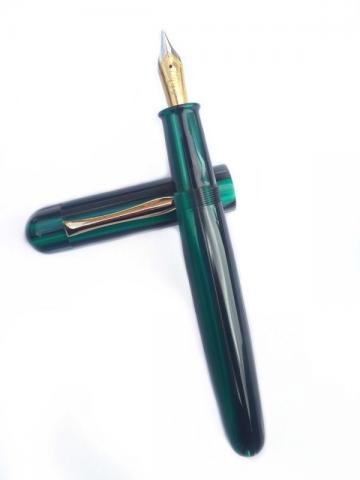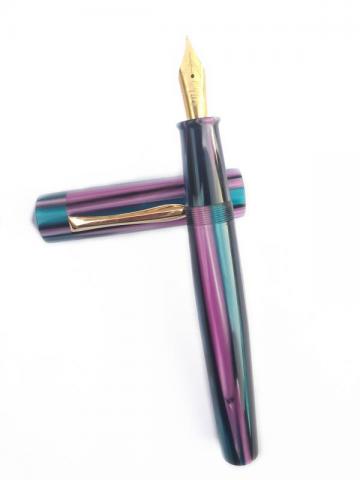Search the Community
Showing results for tags 'taiwan'.
-
desaturated.thumb.gif.5cb70ef1e977aa313d11eea3616aba7d.gif)
尚羽堂 Fine Writing International (domiciled in Taiwan) and Wancher linked?
A Smug Dill posted a topic in China, Korea and Others (Far East, Asia)
I've long known that 尚羽堂 Fine Writing International's Chinese Constellations series and Wancher's Crystal series of fountain pens are essentially the same model just branded differently and offered in different (mutually exclusive) colourways, and FWI's Planets series and Wancher's Crystal II series must have rolled off the same production line. So, why on Earth was I still surprised when I came across these images, in a listing for the Chinese Constellations series on Taobao this morning? Source: Taobao item listing-
- 尚羽堂
- fine writing international
-
(and 6 more)
Tagged with:
-
This is a review of SKB Ink-220, what I call "Sky Blue" On my recent trip to Taiwan, I found a bottle of SKB Ink-220. SKB is one of the historic fountain pen manufacturers in Taiwan. The company was established in 1959 and at one time was one of the top 3 Taiwanese fountain pen manufacturers. While not widely known here in the US, they manufacture a wide range of fountain pens. While I am not certain if SKB produces their own fountain pen ink, they market it under their name. The ink comes in a number of colors. I was only able to obtain one - Ink-220. SKB Ink 220 comes in a very nice square glass bottle with a heavy plastic screw on cap. The bottle opening is a standard size, similar to DeAtramentis or J. Herbin bottles. The bottle is fairly deep and holds 30 mL of ink. I purchased the bottle for right around $7.00. According to one of my interpreters, SKB stands for: S = Smooth; K = Knowing; B = Beauty Here is my written review of the ink. The paper used for this review is Cambridge Executive spiral notebook paper - a reasonably smooth, less absorbent paper similar to HP copier paper: Positives: There is some water resistance, although the letters do spread as the paper dries. My sample was submerged for 5 minutes until the paper was fully saturated. The ink appears fairly resistant to water droplets or simple smearing. The ink dries fairly fast - even with a wet nib on Tomoe River paper. It cleans easily from the pen and converters without staining. Negatives: The color is too pale for EF nibs or possibly F nibs. There is some bleedthrough with broad or stub nibs on more absorbent papers. While SKB Ink 220 will likely not be in my regular rotation, it is well behaved, and will be an ink that I will use for special purposes.
-
This series is a celebration of the Taipei metro. The colour represents red of the colour of the Tamshui-Xinyi Line. This is how the bottle looks like, curtesy of Shigure inks. I really like the colour. It’s spot on what I like in a red. It looks spectacular with the wide fude nib: HP 32 paper- Fude/ Fine nibs TR 68gr paper - M/F/Fude nibs Unfortunately for some reason it takes its sweet time to dry, on Rhodia and it's even worse on good Japanese paper.Dry time is alright with fine nibs. Rhodia Midori It has absolutely no water resistance. Not the best ink to write your shopping list/love letters on a rainy day…. You’ll have a Casablanca moment. The ink is slightly on the dry side and needed to be cajoled with a #6 fude nib. But with the other nibs I tested, it had no problems. Though don't expect Doyou style lubrication. I would say it has restrained lubrication Cheap paper: Comparison: • Pen used: Jinhao 450 fude / Lamy Safari • Ghosting: some on thin paper • Bleed through: With a wide nib on cheap paper, yes, otherwise none. • Flow Rate: Alright • Lubrication: Alright • Nib Dry-out: No. • Start-up: Only with a #6 fude nib. • Saturation: yes • Shading Yes. • Sheen: No • Spread / Feathering / Woolly Line: Nope. Maybe on cheap paper with a wide nib • Nib Creep: Nope. • Staining (pen): To be seen.. • Clogging: None. • Water resistance: None • Availability: Only in 30 ml bottles
-
Opus 88 Multi-Review Taiwanese company Opus 88 has recently put out a whole series of dedicated eyedropper-filled pens, and I picked up three of them: the Koloro, the Picnic, and the Fantasia. I think these three models are similar enough to warrant a combined review. http://zobeid.zapto.org/image/pens/opus_88/picnic_koloro_fantasia_uncapped.jpg At the time of writing this, I found both the Picnic and Fantasia on sale — possibly closeout sale. I’m not sure, but it seems that these models may be discontinued while Opus 88 focus on the Koloro, the Demonstrator and the Omar. A Demonstrator might possibly be in my future, but that is not for today. Presentation They all come in a presentation box which is made from cardboard with a black vinyl covering, embossed printing and a magnetic latch. There’s a thin cardboard sleeve to go around the box and keep it closed while being shipped or stored, and there’s a foam insert to protect the contents. When I opened one of these boxes, I thought for a moment the pen was missing! It had, in fact, slipped underneath the insert while being jostled around by the mail service. Personally, I favor smaller boxes with less wasted space (like the presentation cases vintage pens used to come in), but I know the entire pen industry is against me on this, so I guess there’s no point in complaining. http://zobeid.zapto.org/image/pens/opus_88/fantasia_in_box.jpg A little cartoon pamphlet with one side in English and the other in Chinese shows how to fill the pen. You should probably look it over, as there’s a good chance you haven’t had any pens before that work like this. Or else, you can follow my instructions below. All three pens came with a glass eyedropper, although the exact size and design varied a bit. It’s just a little glass pipette with a rubber bulb at one end, and I personally don’t consider it the most ideal tool for the job (more on that below), but it’ll work. The Filling System Well, the filling system is what really makes the Opus 88 line stand out. We’ve got some FPNers converting cartridge/converter pens to eyedropper fill, but most of us don’t have much experience with the purpose-designed “Japanese” eyedropper system and its shutoff valve. The fill process is as follows: Holding the body upright (nib pointed up), unscrew the section and body in the same manner as opening a cartridge/converter pen. Use an eyedropper or syringe to transfer ink from your bottle to the pen body. Screw the section and body back together. http://zobeid.zapto.org/image/pens/opus_88/koloro_and_syringe.jpg Couldn’t be easier. There are a few quirks you need to consider, though. The knob (not really a blind cap) at the tail of the pen controls the shutoff valve. Some of you may already be familiar with a similar shutoff valve used on some (but not all) vacuum-filling pens, such as the TWSBI Vac 700 or the Pilot Custom 823. Its purpose is to prevent ink from “burping” out of the pen due to changes in air pressure (such as when flying or riding an elevator), or when your hand warms the air inside the pen, causing it to expand, and it also reduces the chances of ink being slung or knocked out of the pen during travel. Contrary to what some have assumed, you do not need to open the shutoff valve to fill the pen. You also don’t need to open it for jotting brief notes, as there is a tiny ink chamber available when the valve is closed, but you will need to open it for more extended writing sessions. The shutoff knob has another useful function that I haven’t seen mentioned elsewhere. Although there is no piston or plunger in this pen, moving the knob and rod in and out does displace a small amount of ink or air, and it can be used to pump a drop of ink into the feed. If you’ve just filled a dry pen, and you need to prime the feed and get ink flowing, this is the easiest way to do it. I’ve struggled sometimes with cartridge pens, getting a dry pen with a fresh cartridge to start writing. That shouldn’t ever be a problem here. Do be careful, though, as you can burp or spatter a drop of ink out of the pen if you manipulate the rod too much! A few minutes of practice with this technique should serve you well. Watch closely and you’ll see the ink flow into and saturate the feed. As already mentioned, the glass eyedropper will do an okay job of filling the pen. However, it doesn’t pick up much ink per squeeze, so you will be going back-and-forth between the bottle and your pen a few times. Also, the tip of the eyedropper is sort of bulbous and doesn’t deposit ink with great neatness or precision. Luckily, there is an alternative. From the Goulet store I picked up a couple of semi-disposable syringes, 2 for $5. These are what I think of as “hummingbird” syringes due to their long, blunt needle. They are graduated up to 5 ml, and they are ideal for taking every last drop from an ink bottle and then putting that ink precisely where you want it, as well as seeing exactly how much you got. They have other uses, such as refilling cartridges, but they really shine for filling eyedropper pens such as these Opus 88s. Maintenance Because these pens open up for filling, and because they use interchangeable nib modules that simply screw in and out, and because there’s no complex filling mechanism, these pens should be easy to maintain, to clean, to assemble and disassemble. One quibble is that the tail end of the pen can’t be disassembled as easily as, for example, a TWSBI. To remove the shutoff valve mechanism requires a special spanner wrench that Opus 88 neglected to supply with the pens. Likewise, if the walls of the ink reservoir pick up any residue, you can’t simply stick a Q-tip in there and wipe it off, since the shutoff valve is in the way. (I’d suggest not using Baystate Blue in these!) Also, much like TWSBIs, these Opus 88s rely on O-ring seals in several different places. Some of these are easy to see and access, some not. All of them could benefit from a little lubricant, but none of them came with any. In fact, the shutoff knobs on some of these pens squeak-squeak-squeaked when I operated them. The O-rings on the valve itself and where the section and body go together also felt sticky. I really wish that Opus 88 had included a little vial of silicone oil, such as you get with TWSBI pens. Luckily, I had both silicone oil and grease on hand. If you don’t, you might consider picking some up when you order any of these pens. Please do not try to substitute any random oil or grease that you may have! Petroleum-based lubricants can damage O-rings. That means no Vaseline, no Lubriplate or M1 Rifle Grease, no WD-40 or Break Free, no 4-in-1 Oil, etc. If you can’t get actual silicone grease or oil, then Super Lube synthetic grease or Crosman Pellgunoil should be safe substitutes. http://zobeid.zapto.org/image/pens/opus_88/koloro_and_lubricants.jpg I lubricated the valve operating rod, the body-and-section seal, the tiny O-ring at the base of the feed housing (more on that later) and the valve itself. The squeaking and stiffness went away. I applied some extra grease to the section threads and to the cap threads, just to provide a little extra smoothness and sealing for ink and air. All three of these pens hold roughly 2 ml of ink. In fact, if I stop filling just short of the section threads, which I think is good practice, then the total is just short of 2 ml. When you see claims that eyedropper pens hold “a ton of ink”, let's put that in perspective and remember that a Sheaffer Skrip cartridge is supposed to come from the factory with one ml, and a Lamy 2000 holds about the same. Two ml is a very healthy amount, hyperbole not needed. Design & Construction I'll say right up front: These are well made pens. Parts are well-fitted; there are no gaps or rough edges. Machine work and threading is very clean. Surfaces are nicely polished. Most of all, they're made from two of the most time-tested of all pen materials: ebonite and acrylic. All of the pen bodies and sections are made from translucent acrylic. The Koloro and the Fantasia both have shutoff knobs made of ebonite. The Fantasia’s cap is made from ebonite, and the Koloro’s cap is made from a combination of ebonite and acrylic parts. I think the Koloro and Fantasia would look and feel a bit nicer if their sections were ebonite too, but that's not a big deal. A natural point of comparison might be that other Taiwanese company: TWSBI. Opus 88s are a fair bit more expensive than TWBSIs, but the materials and construction are markedly better and, I think, hold up well to US brands such as Bexley, Edison or Franklin-Christoph. Those pens don’t break, and I don’t expect Opus 88s to break either. The translucent acrylic body is a great match for an eyedropper pen, since it allows you to easily monitor your ink supply. However, it’s easier in some cases than others. The body of my Fantasia is quite dark brown. When filled with a wet ink that coats the sides of the reservoir (like for example, Diamine Eclipse), it's difficult to gauge the ink level. I have to hold it up to the light, wait a minute for the ink to “settle,” and squint. Frankly, it's easier to keep track of the ink in a C/C pen. With the Picnic it's just the opposite; the pen body is a pale blue, and with a dry ink (like OS Accident) it’s easy to glance and see the ink sloshing around. The Koloro falls somewhere in between, as I can't tell at a glance, but I can hold it up to the light and discern the ink level pretty easily. I have to emphasize that this depends on both the darkness of your chosen body color and the ink you’ve put in. The Koloro was the first of these pens that I bought, and the distinctive two-tone look is part of what attracted me. It’s a clean and modern design, and this beige-and-gray color combo has proven popular. However… In the catalog photos online, the body color looked almost green, like a lovely teal. Some sellers even described it as a beige-and-green. The one I got looks darker and much more neutral gray than those photos. I'd call it "smoke gray". Were the online photos deceptive, or did Opus 88 change the color at some point during production? I would have preferred one that looks like the photos, but it's still an attractive pen. http://zobeid.zapto.org/image/pens/opus_88/size_comparison.jpg The Koloro and Picnic are full-sized pens. Capped, both pens are about 14.4 cm (5⅛”). Both are comfortable to use un-posted, and both of them post “okay” but not great. Either of these can fit neatly into the pen loop in my vest, but wouldn't go if they were any longer or fatter. Obviously, your pen loop may be different from mine, but what I'm saying is that these are about the very largest pens that I'd normally consider carrying away from home. The Fantasia is similar in girth, but shorter, giving it a chunky look. Capped, it’s about 11.7 cm (4⅝"), making it the shortest modern pen in my collection. Uncapped, it’s about 10.3 cm (4"). As a result, I can write with it un-posted, but the very tail of the pen rubs lightly on the web of my hand. For extended writing I would definitely post it, and allowance has been made for this. The tail of the pen has threads for posting. That seems to work very well. However, if you post the cap and then find you have to open the shutoff valve, even more screwing around is going to be needed. The neurotic among us should be aware that the Fantasia’s pocket clip may or may not line up with the nib when posted. On mine it does. The cap finial seems very tightly secured, and I’m not sure if it’s even supposed to be removed or loosened (which would allow repositioning the clip). There is a little leeway to turn the nib assembly, though, if you really care that much. I should also note that the Fantasia section is stubby, and gripping it will result in some finger contact with the cap threads, but this didn’t present any comfort problem to me when writing. If you are particularly sensitive to this issue, you might want to go for the other models with more normal grip style. The color and style of the Fantasia is quite compelling to me. It stands out, and to my eyes it has a sort of 1970s retro vibe. As already mentioned, the Koloro is another pen with distinctive style. The Picnic is plainer and less distinctive, since it has no decorative ebonite bits, and there are any number of other translucent and cigar-shaped pens on the market. That’s not to say it’s bad looking at all. Screw Caps These pens all have screw caps, which is something I wouldn’t usually even comment on, but I’ve seen some complaints about how many turns it takes to uncap them. So, let’s take a look at that: Opus 88 Koloro — 3½ full turns Opus 88 Picnic — 2 full turns Opus 88 Fantasia — 2½ full turnsI checked some other pens, vintage and modern, and it seems like they typically require around one or two full turns. So, the Opus 88s do require a little more. To me this is trivial; even with the Koloro it slows me down by only a small fraction of a second. Some other folks, apparently, find it highly annoying. I do believe that more threads make for a more secure and more airtight cap, for whatever that’s worth. The Nibs All of these three pens come with standard #5 sized nib-and-feed modules and steel Jowo nibs. (The Demonstrator and Omar come with #6 size nibs, though.) I won’t go into great detail about their writing qualities, since they are basically the same as nibs shipped in TWSBIs and many other brands, and they are widely known to be good quality. All three of these were fine tips and wrote well right out of the box. They were adjusted slightly dry, which I've also found to be typical of modern German nibs, but increasing flow is one of the easiest adjustments to make on a steel nib. They do incorporate a nib-feed-and-housing module that is interchangeable with some other brands — but I don’t know which ones! Digging through my parts box, I found a nib assembly with a Bock nib that swapped right in, but I don’t remember where it came from. If anybody else familiar with these pens knows which other brands it can swap with, please say in the comments! When removing the module, you must be careful of the little O-ring right at the base of it, a place where I’ve never seen one used in any other pens. You don’t want this to fall out and get lost. I believe this is supposed to keep ink from going between the feed housing and the section, which wouldn’t cause any harm but can look messy in these transparent, demonstrator-like pens. (I also found that when flushing the feed with a syringe, too much pressure can force water past this O-ring and into the section, which again looks a bit messy.) You don’t have to swap whole modules, though. Bare #5 nibs can be swapped between assemblies with only a little more work and care. Since I wanted a bigger tip with more flow, I swapped a TWSBI medium nib into the Picnic, and it works with no problem. Value & Conclusion If you favor the Japanese eyedropper filling system or just want to give it a spin, these Opus 88s are pretty much your only option now. Nobody else is doing this, while Opus 88 are doing it quite well. For those who are less concerned with the filling system, the value calculation is more complicated. Their prices are in the mid-range: a fair bit above Monteverde or Conklin, a fair bit below Edison or Bexley. My personal evaluation of Opus 88’s quality is closer to Bexley than to Monteverde, so it seems like a pretty good deal to me. And of course, I have to compare with TWSBI. There’s a bit of family resemblance between the products of these two Taiwanese companies: lots of transparent or translucent pens, lavish use of O-rings (unusual among other brands), novel filling methods with large ink capacity, easy disassembly (for the most part), and the use of standard, interchangeable, German nibs. The Picnic is priced much higher than the Diamond 580, and the Demonstrator much higher than the Vac 700R. However, TWSBIs are made of injection-molded polycarbonate and are known to crack, and break, and break again. The Opus 88 pens are made of materials that shouldn’t break, and to me that’s an enormous advantage. As much as I admired TWSBI pens in other respects, I swore off ever buying another due to the breakage problem. From where I sit, these Opus 88s are very welcome replacements.
- 36 replies
-
- eyedropper
- taiwan
-
(and 1 more)
Tagged with:
-
Dear FPN'ers, Greetings !!! This is Kandan.M.P from Ranga Pen Company, India. We are very happy in introducing New RANGA SPLENDOUR Model in 7 different Stripes Acrylic Resin Colors made in Taiwan. As name Indicates, It is Grand , Classic and Strikingly beautiful Pen. These are completely Handmade Pen .This pen is must have for Pen Collector's and Fountain Pen user's. Stripes rules the Fashion and Life style world for last 200 years. We combine it with our Pens now. This is bigger pen. Stripe pattern varies from Pen to Pen The Highlights of these Group buy are 1. Seven beautiful Stripe Colours. These are very High Quality Resins made in Taiwan 2. Cap Closes in just 1 turn3. Wide Variety of Nib Choices4. Three different shapes This Group Buy is Valid till 28-Feb-20 In order to participate in the group buy just fill the Google Form (Link Below) https://docs.google.com/forms/d/e/1FAIpQLScEIl7ES8HVcR8uLwNj64huO6tBY8dRmgz9pwLyyrTOE8Hoog/viewform?vc=0&c=0&w=1 Available Stripes Colours #22 Green Stripes#23 Blue Stripes#24 Golden Stripes#25 Blue/Pink Striples#26 Olive /Black Stripes#27 White/Black Stripes#28 Brown Stripes Prices are as follows:RANGA Splendour:(Thickness-Cap Dia: 19mm, Barrel Dia : 17.5mm , Capped Length - App 170mm )Premium Acrylic- With German Bock/Jowo/Schmidt #6 Screw in Nib and German Schmidt Converter: US $94. (Actual Price is 120$) Shape: 1. Splendour Round 2. Splendour Peak 3. Splendour Torpedo Finish :Polished Finish/ Matte FinishClip Option - Clipless or Gold Clip or Silver ClipClip OptionFor C/C mechanism (with Schmidt K5 Converter) #6 Nib Options (included in price)Nib OptionBock Extra Fine Nib - Black Lacquered, Red Lacquered Bock Fine Nib- Chrome Tone ,Gold Tone,Dual Tone , Black Lacquered, Red Lacquered Bock Medium Nib- Chrome Tone ,Gold Tone,Dual Tone , Black Lacquered, Red Lacquered Bock Broad Nib- Chrome Tone ,Gold Tone,Dual Tone , Black Lacquered, Red Lacquered Bock Calligraphy 1.1 Nib- Chrome Tone ,Gold Tone ,Black Lacquered, Red Lacquered Bock Calligraphy 1.5 Nib- Chrome Tone ,Gold Tone,, Black Lacquered, Red Lacquered Bock Titanium nibs: Fine Point or Medium Point or Broad Point(59$ Extra)Bock 18K Nib # 6 Size Nibs:- Broad Point (185$ Extra)JoWo Extra Fine Nib -Chrome Tone JoWo Fine Nib - Chrome Tone or Gold ToneJoWo Medium Nib - Chrome Tone or Gold Tone JoWo Broad Nib - Chrome Tone or Gold ToneJoWo 1.1 Calligraphy Nib - Chrome Tone or Gold ToneJoWo 1.5 Calligraphy Nib - Chrome Tone or Gold Tone Schmidt Fine Nib - Gold Tone or Chrome ToneSchmidt Medium Nib - Gold Tone or Chrome Tone Schmidt Broad Nib - Gold Tone or Chrome ToneNo Nib - Threaded for Bock #6 (less USD -12)No Nib - Threaded for JoWo #6 (less USD -12)No Nib - Threaded for Schmidt #6 (less USD -12)No Nib - Threaded for Bock #8 Via Registered Post which is included in Price and takes 2 -4 Weeks.Shipping: Via India Post REgister PostMaking Time: 4-5 Weeks after paymentPaypal id- mpkandan@gmail.com If you buy More than 2 Pens and if you don't want to fill the form, You can directly send the specs to our mail id mpkandan@yahoo.co.in In order to participate in the group buy just fill the Google Form (Link Below) https://docs.google.com/forms/d/e/1FAIpQLScEIl7ES8HVcR8uLwNj64huO6tBY8dRmgz9pwLyyrTOE8Hoog/viewform?vc=0&c=0&w=1 Thanks for your continuous support Regards,Kandan.M.PRanga Pen Company
-
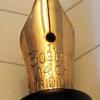
Fine Writing Bronze Age Ef (Expanding Long-Term Review)
TheDutchGuy posted a topic in Fountain Pen Reviews
Context Fine Writing is a Taiwanese company, making mostly high-end pens. Their more affordable pens tend to have striking designs and consist of a series of time-limited models. What's in stores now will not be there forever and what Fine Writing might cook up next is unknown until they release it. There are two earlier Fine Writing reviews here on FPN, as far as I could determine: one for the Bronze Age and one for the Golden Armour. When I first saw photos of the Bronze Age, I knew I had to have one, even though I'd vowed never to buy another pen with a generic Jowo or Bock nib (not that those nibs are inferior, just a matter of personal preference). In other words, this is the first pen that I've ever bought purely because of its design. Packaging, pricing, nib options These pens can be bought in various online stores for prices ranging from €85 ro €99. The nib options are EF, F, M, B and 1.1 mm stub. Nib colours are chrome, gold or black. The pen is packaged in a brown cardboard box and comes with a small booklet, a converter and a pipette. There is no clip. While some may wish for a more lavish box, personally I am happy with the cardboard box. Lavish boxes cost money and I'd rather spend my money on the pen itself. Also, for those who discard boxes, the cardboard can be recycled and is free of plastic and metal. The pen is C/C but can also be eye-droppered, hence the pipette. In eye-dropper mode, the pen holds a HUGE amount of ink, even more than the Opus 88 Demonstrator (which is also an eye-dropper). The converter seems to be identical to the ones that Kaweco uses and appears to be a generic design. Design The design of this pen is striking and I love it, though of course beauty is in the eye of the beholder. The engraved brass cap and filial and the brass section look really nice and the clear acrylic (I assume it is acrylic) barrel make for a unique appearance. The nib is a Jowo #6 engraved with the Fine Writing feather logo. You can unscrew the collar that contains the nib and feed from the pen, which is both easy to do and convenient. I chose an EF. Here are some photos of the various parts of this pen: Dimensions and ergonomy In terms of size, the pen is larger than I'd expected it to be. It's halfway between an Pelikan M800 and an Opus 88 Demonstrator. Below is a picture that compares the Bronze Age to these two pens and to some other pens: a Parker Vacumatic Jr, a Torca, an Onoto #5601, the M800, the Bronze Age, the Opus 88 Demonstrator, an Esterbrook SJ and three Boston pens. Despite its size and appreciable weight, the pen fits my hand very well indeed. To my surprise, it is very comfortable to hold and I can use it for longer periods of time without fatigue. I don't have to search for the right way to hold it. For me, that is quite rare. Only a few of my pens offer me such ease and comfort, though of course this is very personal and subjective. The nib and how it writes Because I prefer narrow lines and an uncluttered, open, clean appearance of text, I chose an EF. That is somewhat of a risk with generic nibs from brands like Jowo and Bock. I've seen many such EF's with asymmetric nib cuts, misaligned tines and other maladies. A good EF, which writes a crisp, narrow line with enough smoothness to be pleasant and comfortable, but also with enough tactile response for good control, that's not easy to do. The F nib on my Opus 88 Demonstrator is also a #6 Jowo and I lucked out with that one - it's a really good steel nib that gives me pleasure every time I use it. So, how well does the EF of the Bronze Age hold up...? Well, pros and cons, really. Proper flow of ink right out of the box, not too dry, not too wet. But it will become a lot wetter once more ink goes out of the barrel and more air comes in (if you don't want that, use a cartridge or a converter). Only a few words of writing were enough to alert me that the tines were not completely aligned. Visual inspection quickly confirmed what my hand had already told me: they were slightly but noticeably misaligned. Something else that I immediately noticed was a certain degree of 'character' to the writing, a very subtle difference in line width between downstrokes, sidestrokes and diagonal strokes. While I adore such an appearance of the written text, in an EF nib it is usually a sign of an asymmetric nib cut and indeed my Bronze Age has such an asymmetric cut (though I have seen much worse). Basically this means that the slit is not in the middle, so one tine is larger than the other. Sometimes the smaller of the two tines is slightly rotated so that the slit is not of equal width from top to bottom. As I mentioned, this is not uncommon and I have seen it on steel nibs from Kaweco, Leonardo (both Bock), Bock itself and Jowo. If you're lucky, the asymmetric cut will add character to your writing without feeling rough, without drag and without flow issues. In this sense I've been lucky several times, but initially the Bronze Age was sub-par. The nib offered good control, had good flow but it just did not feel right. On Rhodia, there was noticeable drag and on all papers that I tested on, some styles of writing just had too much unpleasant feedback, whereas other styles felt smooth. I had to search for a pleasurable writing experience and I don't want to do that - I want the pen to please me, instead of me finding a way to please the pen. Anyway, it took me half a minute to align the tines and another minute to find and remove the minuscule burr that caused the unpleasant feedback. In terms of control, tidiness, character and comfort of writing, the pen immediately became a pleasure to use in every style of writing that I know. Of course, this is a rigid nib and you should not try to flex it in any way. Here are some writing samples on Rhodia, Oxford and Tomoe and a comparison with some other well-known pens: ^--Oxford 90 g/m^2, comparison with Sailor 1911 Standard (M) in top row ^---Tomoe ^--Rhodia ^--Comparison of various other well-known pens Verdict A pen is meant for writing, and the writing is done with the nib, so the business end of a pen has to be really good and really pleasurable. That steel Jowo #6 is the least expensive but most important part of this pen. It required a few interventions on my part to make it do what it is supposed to do, but to be fair many pens using nibs like this require some tuning. Once that was done, wow. The design, execution, comfort, size, ink volume (4 mL!!)... just wow. I can see myself putting in a gold nib at some point in the future, but I did 90 minutes of non-stop writing with the pen and every minute was rewarding, relaxing and enjoyable. The luxury of being able to choose a cartridge, a converter or to eye-dropper it is quite nice. For what this thing costs, you get one helluva pen. I can see myself becoming very attached to this pen very fast. Edit: added additional info on nib removal.- 18 replies
-
- fine writing
- bronze age
-
(and 4 more)
Tagged with:
-
Looking For Information About Bee Pens In Taiwan
basterma posted a topic in China, Korea and Others (Far East, Asia)
I bought this from the Egyptian stationary chain Samir and Aly in 2010. It writes well and has clean molding and is much better than I expected for a 3$ pen. I could not find anything about the company and the nib is not an IPG and the nib engraving is not helpful. https://imgchr.com/i/1AR9C8 https://imgchr.com/i/1A0f0O https://imgchr.com/i/1A0WnK https://imgchr.com/i/1A02X6 -
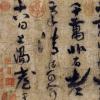
Fine Writing International --Bronze Age
seimodern posted a topic in China, Korea and Others (Far East, Asia)
During a recent trip to Berlin, I happened to stay near the excellent Papeterie Moranga (just off Winterfeldtplatz), and came across two beautiful pens from Taiwan that I'd never seen in the wild before. One was the Bronze Age eyedropper/converter (which I purchased) and another was the more recent version, Gold Armour, which another FPner writes a wonderful review of here. If you are in the US, I believe there are one or two online stores that carry these pens, but they are (so far) relatively difficult to track down. These pens are so great, though, that I imagine they will become much more visible in the next few years. To my eye, they are as interesting, if not more, than the Opus eyedroppers. Highly recommended! The pens are a striking combination of brass and transparent acrylic (at least I am assuming it's acrylic), which can double as both an eyedropper and converter. I was torn between them, but ultimately went with the faceted edges of the Bronze Age. (The Gold Armour version features a round cap that has small points to prevent it from rolling, and can also come with a beautiful bronze colored nib.) I have no connection to Moranga or Fine Writing International--just a happy pen-owner! And if you are in Berlin, Moranga also has a lot of other wonderful stationary items--including new Midori notepads that I haven't yet found for sale in the US. The owner is also super friendly, and let me try out a ton of pens, including the newish line of Sailor Naginata Togi nibs.-
- eyedropper
- bronzeage
-
(and 2 more)
Tagged with:
-

Fine Writing International Golden Armour Brass Pen
taike posted a topic in China, Korea and Others (Far East, Asia)
Taiwan pen maker (and stationary products importer) Fine Writing International (尚羽堂) has released the 6th generation of their brass pen. The cap is a big part of the story of this pen. This is the first round cap in the series. The others were octagonal. It's also more ornate that previous iterations. It's crazy-cool. The design is inspired by patterns found in Chinese armour. It looks like the Mountain pattern armour (山文铠) which first appeared in the Tang Dynasty. Then there's the lion with the dagger in its mouth on the end of the cap. The concept is that given that the pen is mightier than the sword, it should be helpful to armour-up your pen (and give it a knife-baring mascot). The pen uses a #6 Jowo steel nib and comes with a converter. Eyedroppering is a natural, however. There's a o-ring on the section. I added silicon grease to the section threads. The cap itself is about 25g making the capped pen over 50g. Sans cap it is a much more reasonable weight - with a full barrel of ink. Capped 140mmUncapped 130.5mmSection diameter: 10.3 -11.9mmBarrel diameter: 13mmThe design balances the pen's proportions very well. The size and diameter of the section is comfortable. The length natural. The diameter of the barrel feels right. I got mine with a 1.1 stub. It's also available with EF, F, M, and B nibs. I picked KWZ Brown-Pink. The pen holds 4ml according to the included booklet. Writing with the Golden Armour is a treat. The nib couldn't be smoother and gives gentle but clear line variation. It's wet without being a gusher. The pen wrote perfectly from the first. The weight of the pen calms my writing - as much as that's possible. I find watching the letters form inspiring. Fine Writing International is far from a household name - though they are getting more attention lately. You may have seen their Planets series. I feel fortunate to have had my head up when this pen came along. The pen was just over US$90 direct from Fine Writing International. I understand retailers in the UK and Japan stock this pen. Not sure about the US. But FWI ships internationally as does Taipei retailer TY Lee. More pictures and comments here.- 6 replies
-
- eyedropper
- brass pen
-
(and 2 more)
Tagged with:
-
Concise, minimalistic presentation, useful for comparison. Text is laconic somehow poetic never ever negative. Tactful. I've been following his ink presentations for a year. One ink every day. 654 inks till now. Many Sailor LEs. Does have a search engine. You can use google translation. http://happyinkdays.hatenablog.com This one from Taiwan. On tweeter. Totally mute. https://twitter.com/yveslee_TW Thanks to both of them, if they read me. I really enjoy their work. David.
- 9 replies
-
- sailor inks
- sailor
-
(and 6 more)
Tagged with:
-
I was looking at the statistics for the 2017 Pelikan Hubs and was curious to see that Taiwan had the second largest number of registered attendees with USA in first place. In fact, Taiwan outranked number three Germany by a large factor. Are Pelikans especially popular in Taiwan? Or maybe the Taiwanese are just especially gregarious people. stats here: https://thepelikansperch.com/2017/07/08/pelikan-2017-hubs-locations/?fref=gc
-

I Have A Twsbi Eco, Do I Want A Wing Sung 698?
antichresis posted a topic in China, Korea and Others (Far East, Asia)
Hi guys, I have a TWSBI Eco. It's a good, competent pen, smooth, with a large ink capacity,I like screw caps, and it's inexpensive. On the other hand I'm not in love with the pen. I borrowed a lot of Ecos (probably a dozen or more) from friends before and I was never struck by how good they were. They were nice, and I knew I was going to try one eventually—if a good deal came my way—but it wasn't high on my list. I just felt that it lacked a bit of character, a bit of a quirkiness. From that and from your own experiences, should I get a Wing Sung 698? What does the 698 have that an Eco does not, why do you like one over the other? For additional context I have a 659 I bought last year. Again, a good pen, but I don't find myself reaching for it. There was also a problem with the feed (ink would not come down) that I eventually fixed. From what I understand, the 698 and the 659 have the same writing end (I also have a couple of 78G pens from <F> to <B>). Besides the piston filler capacity, what does the 698 bring to the table that those two don't? Does it feel better in the hand, is it better made? Lastly, I got the 659 because I like demonstrators and I love clear feeds. However, the feed on mine has stained. I don't recall what ink I had in the pen, but I don't think it was any problematic ink because it's only the feed that got stained and not the section or the converter although it is also possible that I had the pen inked much more than usual (didn't reach for it much), but did you get your 698 feed stained? With what ink? -
Hi! Some engraving concerns here: My wife gave me a MB classique Platinum fountain pen as her wedding gift to me. She bought it at a MontBlanc Boutique here in Manila. And I'm planning to have it engraved with my Chinese name on it, sadly the MB here in the Philippines can't engrave in CHinese characters. We'll be heading to Taiwan for a few days at the end of Jan. and I was wondering if I could also avail the free engraving of my MontBlanc Pen in Taiwan with my name in Chinese Characters even though it was purchased in the Philippines? And oh, do they really engrave it for free? Thanks and happy doodling to you all.
-
Hello, Hopefully I've decided on the right section to ask this question. I am currently dating someone who is from Taiwan. He enjoys using fountain pens (and rarely uses any other writing instrument) so I had decided that, as part of his Christmas gift this year, I would get him 2 pens: one from Taiwan (to represent where he was born) and one from Canada (where we reside now). I am fairly certain I have been able to locate a local pen maker where I will purchase the Canadian pen but I am having a difficult time discovering what legitimate brands are out there from Taiwan. I have been able to look at an online store for TY Lee and I've looked at the Tenny site but, as both of them are in Chinese, I'm a little hesitant to settle on something as of yet. If anyone has any assistance they can provide, whether it be a good retailer or even just some brands to look out for, I would greatly appreciate it! Thank you! - Samantha

